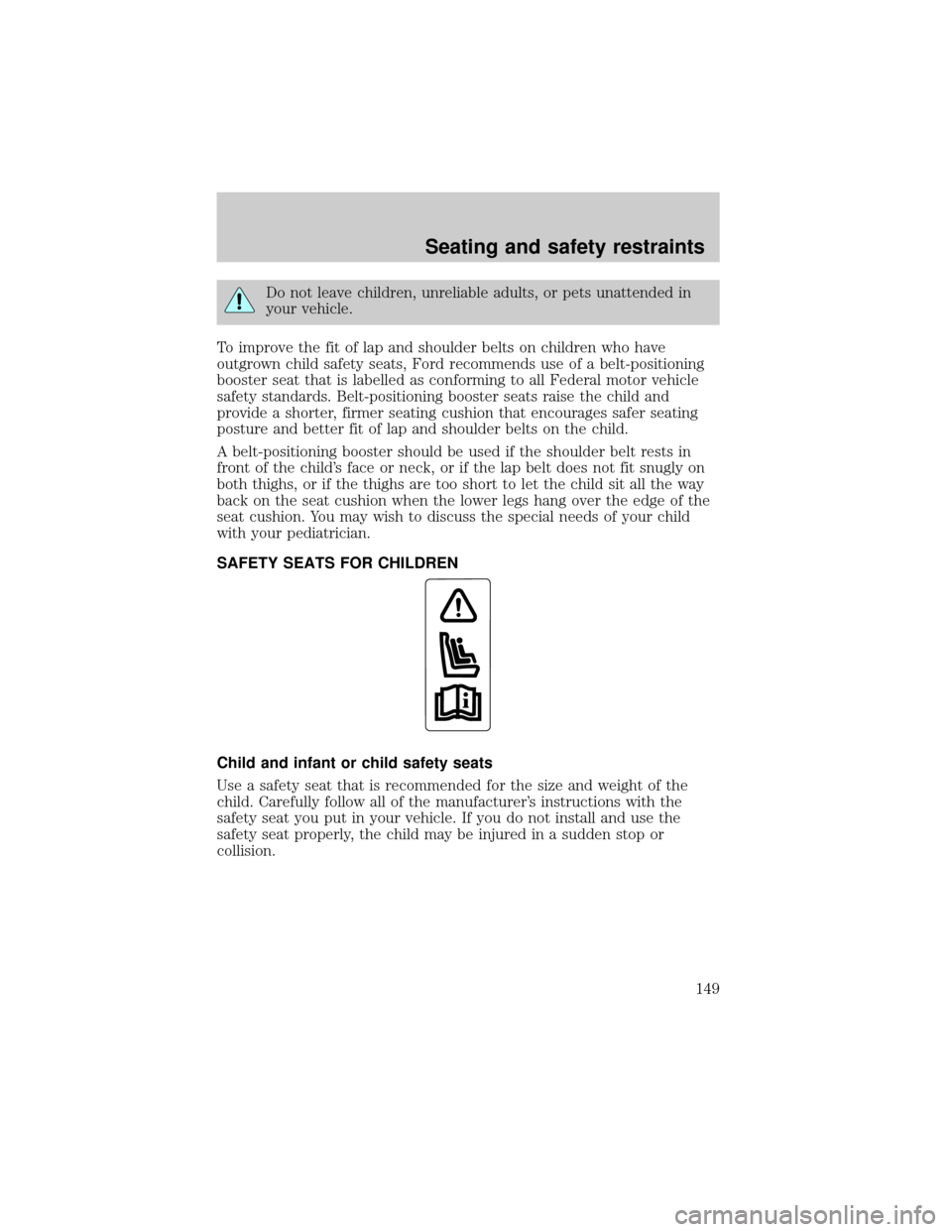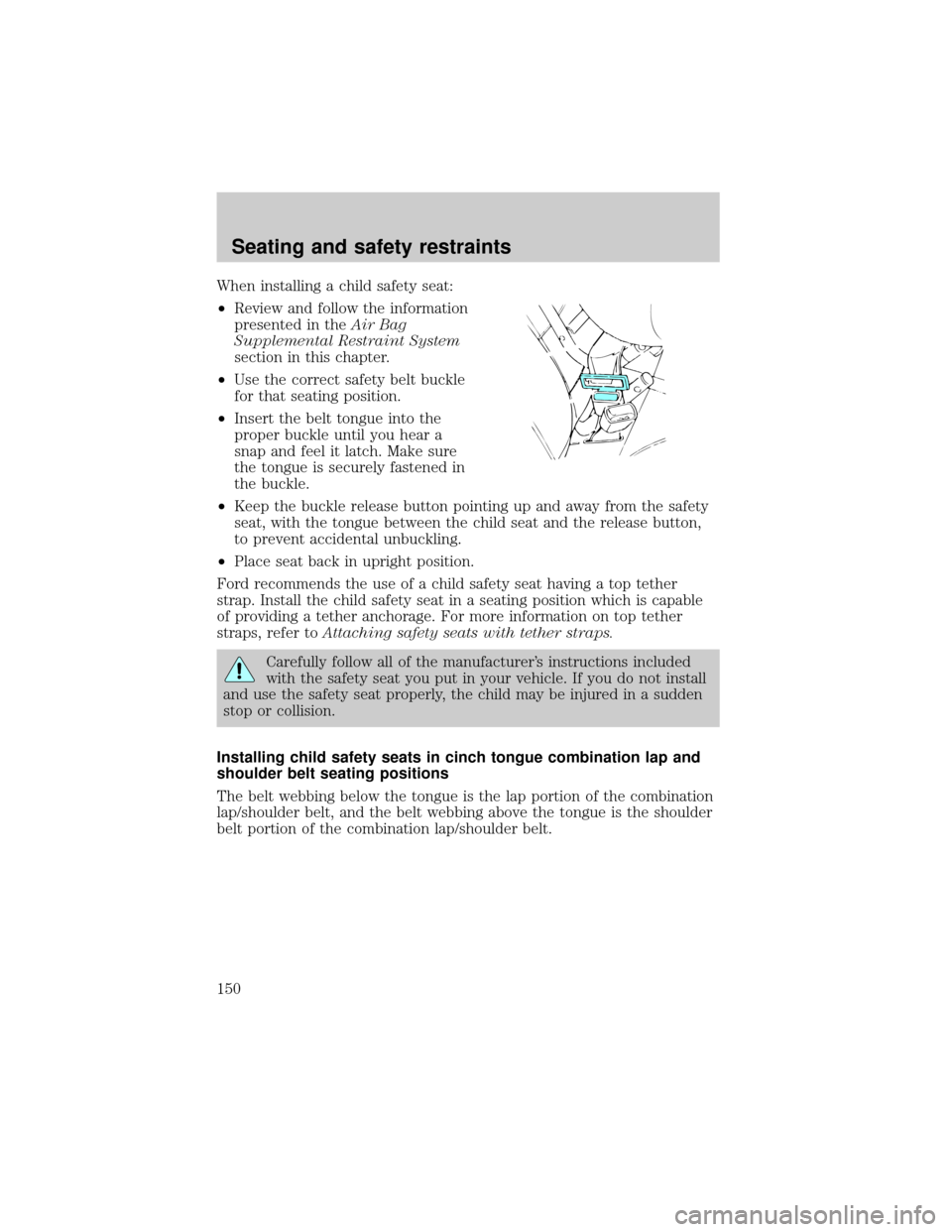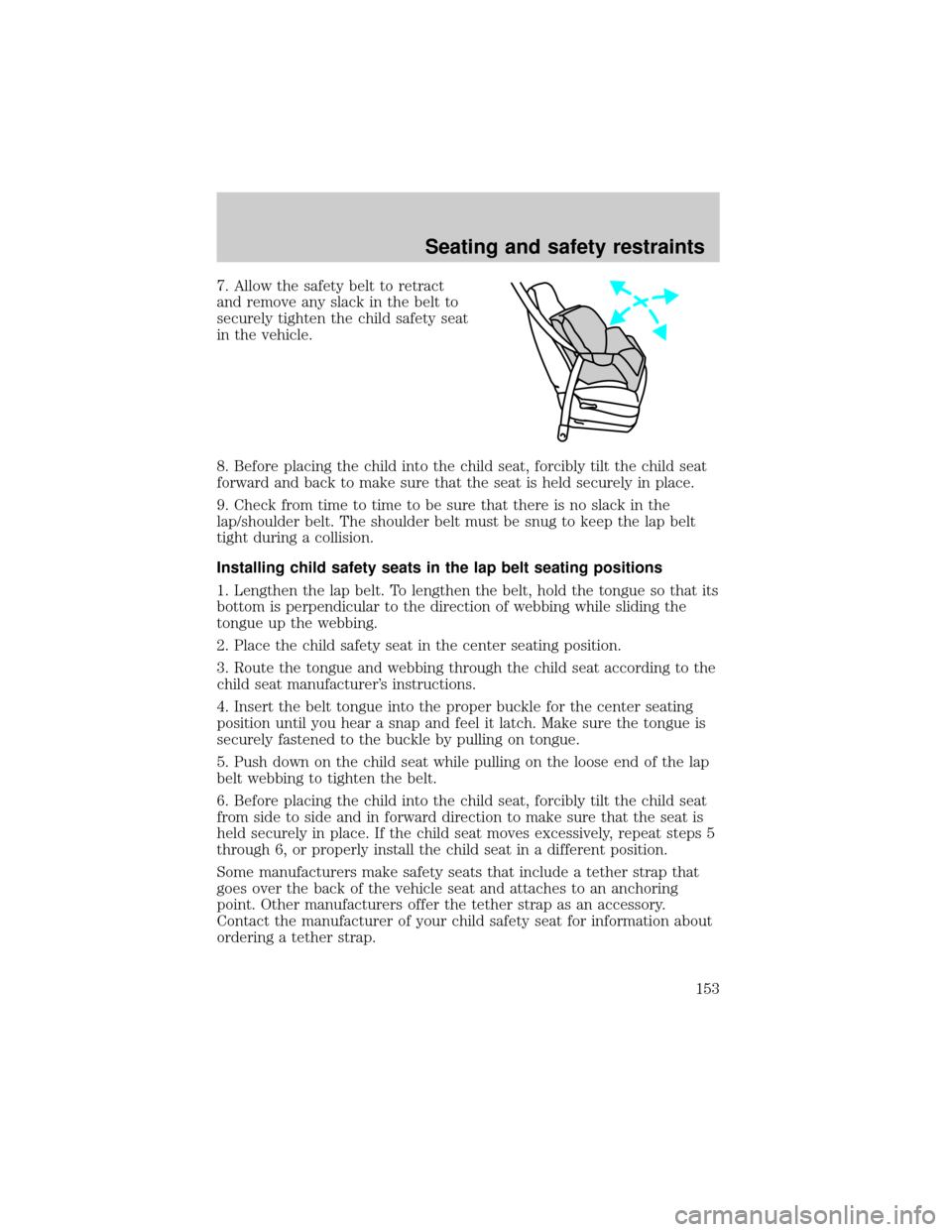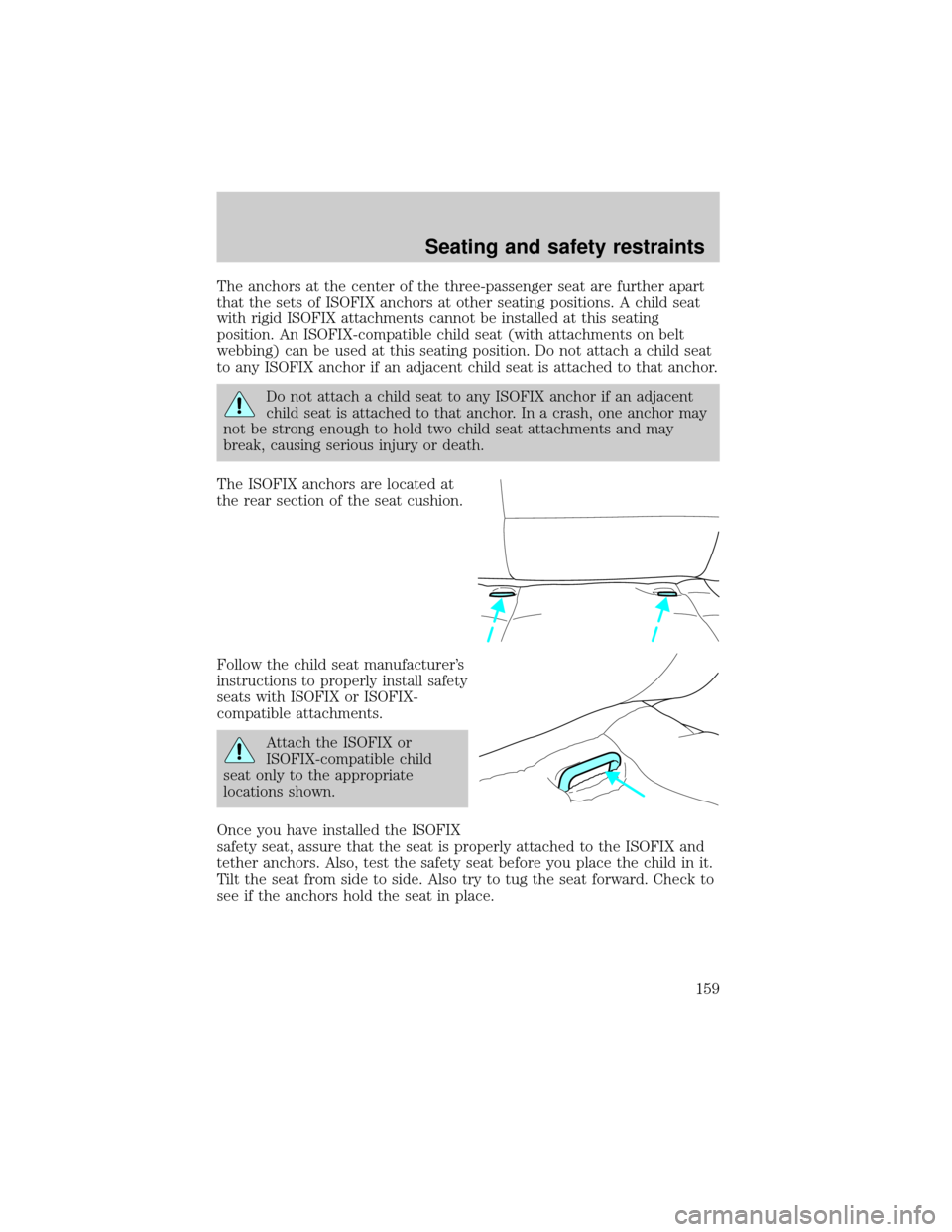Page 149 of 280

Do not leave children, unreliable adults, or pets unattended in
your vehicle.
To improve the fit of lap and shoulder belts on children who have
outgrown child safety seats, Ford recommends use of a belt-positioning
booster seat that is labelled as conforming to all Federal motor vehicle
safety standards. Belt-positioning booster seats raise the child and
provide a shorter, firmer seating cushion that encourages safer seating
posture and better fit of lap and shoulder belts on the child.
A belt-positioning booster should be used if the shoulder belt rests in
front of the child's face or neck, or if the lap belt does not fit snugly on
both thighs, or if the thighs are too short to let the child sit all the way
back on the seat cushion when the lower legs hang over the edge of the
seat cushion. You may wish to discuss the special needs of your child
with your pediatrician.
SAFETY SEATS FOR CHILDREN
Child and infant or child safety seats
Use a safety seat that is recommended for the size and weight of the
child. Carefully follow all of the manufacturer's instructions with the
safety seat you put in your vehicle. If you do not install and use the
safety seat properly, the child may be injured in a sudden stop or
collision.
Seating and safety restraints
149
Page 150 of 280

When installing a child safety seat:
²Review and follow the information
presented in theAir Bag
Supplemental Restraint System
section in this chapter.
²Use the correct safety belt buckle
for that seating position.
²Insert the belt tongue into the
proper buckle until you hear a
snap and feel it latch. Make sure
the tongue is securely fastened in
the buckle.
²Keep the buckle release button pointing up and away from the safety
seat, with the tongue between the child seat and the release button,
to prevent accidental unbuckling.
²Place seat back in upright position.
Ford recommends the use of a child safety seat having a top tether
strap. Install the child safety seat in a seating position which is capable
of providing a tether anchorage. For more information on top tether
straps, refer toAttaching safety seats with tether straps.
Carefully follow all of the manufacturer's instructions included
with the safety seat you put in your vehicle. If you do not install
and use the safety seat properly, the child may be injured in a sudden
stop or collision.
Installing child safety seats in cinch tongue combination lap and
shoulder belt seating positions
The belt webbing below the tongue is the lap portion of the combination
lap/shoulder belt, and the belt webbing above the tongue is the shoulder
belt portion of the combination lap/shoulder belt.
Seating and safety restraints
150
Page 151 of 280
1. Position the child safety seat in a
seat with a combination lap and
shoulder belt.
Air bags can kill or injure a child in a child seat. If you must use
a forward-facing child seat in the front seat, move seat all the
way back.
Rear facing seats should NEVER be placed in the front seats.
2. Grasp the belt webbing below the
tongue and pull as much of the belt
out of the retractor as possible. Hold
the belt out.
3. With your other hand, grasp the
tip (metal portion) of the tongue
(not the cover) and slide the tongue
up the webbing as far as it will go.
Release the tongue, but do not let
go of the lap portion of the belt
webbing.
Seating and safety restraints
151
Page 152 of 280
4. While holding the shoulder and
lap portions together, route the
tongue and webbing through the
child seat according to the child
seat manufacturer's instructions. Be
sure that the belt webbing is not
twisted.
5. Insert the belt tongue into the
proper buckle for that seating
positions until you hear a snap and
feel it latch. Make sure the tongue is
securely latched to the buckle by
pulling on the tongue.
6. While pushing down with your
knee on the child seat pull up on
the shoulder belt portion to tighten
the lap belt portion of the
combination lap and shoulder belt.
Seating and safety restraints
152
Page 153 of 280

7. Allow the safety belt to retract
and remove any slack in the belt to
securely tighten the child safety seat
in the vehicle.
8. Before placing the child into the child seat, forcibly tilt the child seat
forward and back to make sure that the seat is held securely in place.
9. Check from time to time to be sure that there is no slack in the
lap/shoulder belt. The shoulder belt must be snug to keep the lap belt
tight during a collision.
Installing child safety seats in the lap belt seating positions
1. Lengthen the lap belt. To lengthen the belt, hold the tongue so that its
bottom is perpendicular to the direction of webbing while sliding the
tongue up the webbing.
2. Place the child safety seat in the center seating position.
3. Route the tongue and webbing through the child seat according to the
child seat manufacturer's instructions.
4. Insert the belt tongue into the proper buckle for the center seating
position until you hear a snap and feel it latch. Make sure the tongue is
securely fastened to the buckle by pulling on tongue.
5. Push down on the child seat while pulling on the loose end of the lap
belt webbing to tighten the belt.
6. Before placing the child into the child seat, forcibly tilt the child seat
from side to side and in forward direction to make sure that the seat is
held securely in place. If the child seat moves excessively, repeat steps 5
through 6, or properly install the child seat in a different position.
Some manufacturers make safety seats that include a tether strap that
goes over the back of the vehicle seat and attaches to an anchoring
point. Other manufacturers offer the tether strap as an accessory.
Contact the manufacturer of your child safety seat for information about
ordering a tether strap.
Seating and safety restraints
153
Page 156 of 280
4. Rotate the tether strap.
5. Clip the tether strap to the seat
frame.
If the tether strap is clipped
incorrectly (as shown) the child
safety seat may not be retained
properly in the event of a
collision.
6. Rotate the tether strap clip.
7. Refer to the instructions in this
section underInstalling child
safety seats in cinch tongue
combination lap and shoulder belt
seating positionsto secure the
child safety seat.
Seating and safety restraints
156
Page 158 of 280
²3rd row bench
For additional important safety information on the proper use of
seatbelts, child seats and infant seats, please read the entireSeating
and safety restraintschapter in this owner's guide.
Attaching child safety seats with ISOFIX attachments
Some child seat manufacturers make safety seats that are labeled as
ISOFIX or ISOFIX compatible child seats. These seats include two rigid
or webbing mounted attachments that connect to two anchors at specific
seating positions in your vehicle. This type of child seat eliminates the
need to use seat belts to attach the child seat. For forward-facing child
seats, the tether strap must also be attached to proper tether anchor
point. For information on using tether straps with the child safety seats,
refer toAttaching safety seats with tether strapsin this chapter.
ISOFIX anchors have been provided
in your vehicle at the following
locations:
Seating and safety restraints
158
Page 159 of 280

The anchors at the center of the three-passenger seat are further apart
that the sets of ISOFIX anchors at other seating positions. A child seat
with rigid ISOFIX attachments cannot be installed at this seating
position. An ISOFIX-compatible child seat (with attachments on belt
webbing) can be used at this seating position. Do not attach a child seat
to any ISOFIX anchor if an adjacent child seat is attached to that anchor.
Do not attach a child seat to any ISOFIX anchor if an adjacent
child seat is attached to that anchor. In a crash, one anchor may
not be strong enough to hold two child seat attachments and may
break, causing serious injury or death.
The ISOFIX anchors are located at
the rear section of the seat cushion.
Follow the child seat manufacturer's
instructions to properly install safety
seats with ISOFIX or ISOFIX-
compatible attachments.
Attach the ISOFIX or
ISOFIX-compatible child
seat only to the appropriate
locations shown.
Once you have installed the ISOFIX
safety seat, assure that the seat is properly attached to the ISOFIX and
tether anchors. Also, test the safety seat before you place the child in it.
Tilt the seat from side to side. Also try to tug the seat forward. Check to
see if the anchors hold the seat in place.
Seating and safety restraints
159